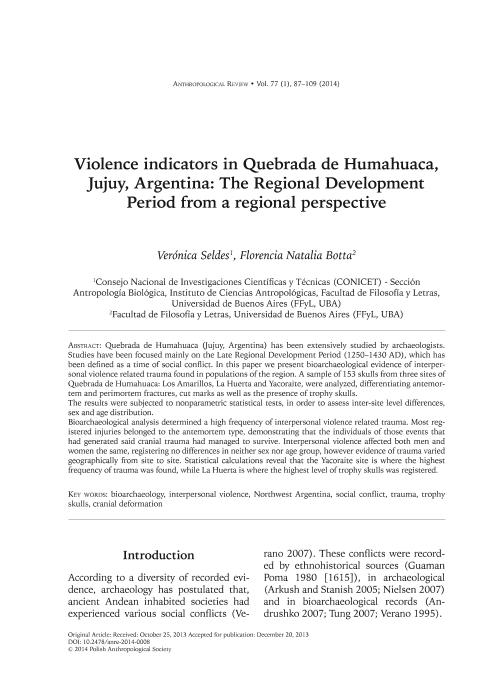Artículo
Violence indicators in Quebrada de Humahuaca, Jujuy, Argentina: The Regional Development Period from a regional perspective
Fecha de publicación:
01/2014
Editorial:
De Gruyter
Revista:
Anthropological Review
ISSN:
2083-4594
Idioma:
Inglés
Tipo de recurso:
Artículo publicado
Clasificación temática:
Resumen
Quebrada de Humahuaca (Jujuy, Argentina) has been extensively studied by archaeologists. Studies have been focused mainly on the Late Regional Development Period (1250 1430 AD), which has been defined as a time of social conflict. In this paper we present bioarchaeological evidence of interper-sonal violence related trauma found in populations of the region. A sample of 153 skulls from three sites of Quebrada de Humahuaca: Los Amarillos, La Huerta and Yacoraite, were analyzed, differentiating antemortem and perimortem fractures, cut marks as well as the presence of trophy skulls. The results were subjected to nonparametric statistical tests, in order to assess inter-site level differences, sex and age distribution. Bioarchaeological analysis determined a high frequency of interpersonal violence related trauma. Most registered injuries belonged to the antemortem type, demonstrating that the individuals of those events that had generated said cranial trauma had managed to survive. Interpersonal violence affected both men and women the same, registering no differences in neither sex nor age group, however evidence of trauma varied geographically from site to site. Statistical calculations reveal that the Yacoraite site is where the highest frequency of trauma was found, while La Huerta is where the highest level of trophy skulls was registered.
Palabras clave:
Bioarchaeology
,
Interpersonal Violence
,
Northwest Argentina
,
Social Conflict
Archivos asociados
Licencia
Identificadores
Colecciones
Articulos(SEDE CENTRAL)
Articulos de SEDE CENTRAL
Articulos de SEDE CENTRAL
Citación
Seldes, Verónica; Botta, Florencia Natalia; Violence indicators in Quebrada de Humahuaca, Jujuy, Argentina: The Regional Development Period from a regional perspective; De Gruyter; Anthropological Review; 77; 1; 1-2014; 87-109
Compartir
Altmétricas




